
Dragon Quest III HD-2D Remake Review
Dragon Quest III was never my favorite of the classic Dragon Quest games, but it’s hard not to respect it if you value gaming’s early landmark titles. When I was binging the series during quarantine a couple years back, it stood out to me amongst its siblings on the NES. Dragon Quest I and II were busy trying to invent the wheels of the early JRPG genre, but III massively increased the scope. Due to its popularity and legendary status, it has already been remade several times, usually based on the great Super Famicom Remake. The most recent of these releases playable today are the mobile and Switch versions, but both of these felt a bit “off”, whether in visuals or controls. After all these years though, we finally have a new version of a classic game that can recognize its legacy with the new HD-2D remake.
There’s a story here, and a solid one for the era, but nothing too high concept. On the day your protagonist turns sixteen,the king tasks you with a globe-trotting adventure across the world to find a way to defeat the Archfiend Baramos. Your father, a warrior named Ortega, was once tasked with the same mission, but vanished mysteriously. From here your adventure is your own. Recruit three party members, name them after your friends (or anime characters, I won’t judge) and go make a name for yourself.
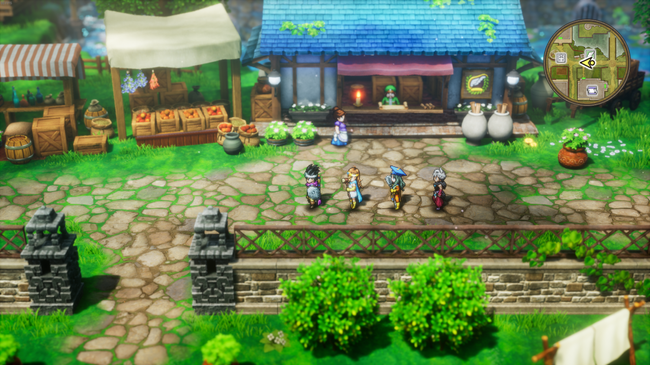
I’ll say now that if you come to RPGs exclusively for a fun cast of characters who have an active role in the story that unfolds, this game likely isn’t for you. Dragon Quest III is an old-school RPG, and the remake maintains its classic stylings before party characterization began to develop in the franchise. Your cast of characters is largely silent, with their utility in battle and on the field being the most important thing about them. Ironically, the only time I remember them talking was when the party member I named after my girlfriend shamed me for seeing the game’s Puff-Puff scene. Thanks for the anxiety, Dragon Quest. The story happens around your party, mainly existing to drive you forward in your adventure. You as the player affect the world around you, but your party aren’t characters. In short, this is one of those gameplay-first RPGs.
Dragon Quest III was always a deceptively linear game, and that’s very much to its benefit. The opening section keeps you locked on an island, but bit by bit the game will expand your freedom until you have access to the entire world to walk, boat, or fly around. Every new town feels like it has something that pushes you forward. Maybe you’ll get a new main story quest, the direction to a cave to get a valuable item, or an NPC with a helpful tip. Every time you expand how you can traverse the world, there’s plenty more to uncover. When you do finally get your boat, most of the map opens up to you, and that sense of freedom has always been a highlight of these classic Dragon Quest games. Little quality-of-life additions like allowing you to Zoom directly from the Map screen keep you always on the move, with little downtime. You're always doing something new in this game.
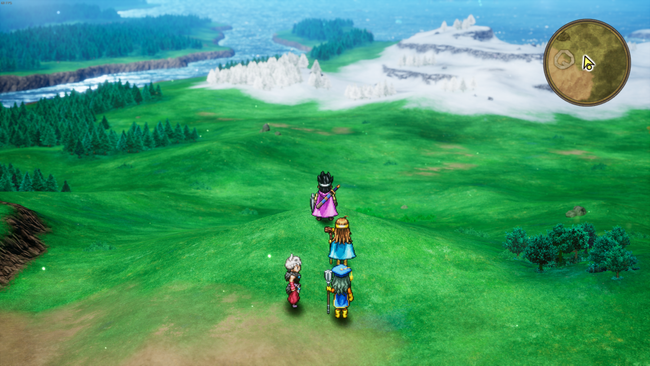
The core gameplay hasn’t been changed in any meaningful ways, but it’s not like Dragon Quest III really needed too many more bells and whistles. Encounters happen at random when roaming the world map or in a dungeon, with battles being turn-based. The upgrade in visual presentation gives them more flair than they ever had before, but most of the magic that sparks serotonin in my brain is from the split-second decision-making. The battle system is easy to understand by just about everyone, but quickly demands a mastery of buffing and debuffing. That, or the patience to just grind everything out. I wouldn’t recommend that, but the freedom is definitely there for those who want it. The HD-2D remake retains that classic design & structure in its balancing act of maintaining the original game’s style while bringing it to a new audience.
The biggest new addition to the battle system is the introduction of a new vocation, the Monster Wrangler. Newly spread throughout the wide world of this remake are friendly monsters you can recruit, usable in the Monster Arena to compete for prizes. The Wrangler will gain new abilities at specific recruitment milestones, and honestly, these monster abilities feel wonderfully overpowered. I was worried about losing my Warrior to make room for this class, but those who put time into combing through the world to recruit monsters will have a really useful glass cannon. Their DPS was crucial for making it through the game’s hardest bosses.

There is a job system in DQIII, and it’s about as simple as it was originally. At a certain point of the game, you reach a place called Alltrades Abbey, which can allow you to change vocations for any party members that aren’t the Hero. As long as they’re at least level 20, any party member can be reclassed while keeping all their abilities. Doing this will drop their level back to one and halves their current stats, but with proper gear, it won’t take long to get them back on par with the rest of your team.
The only “upgraded” class on offer are Sages, which are probably the best class in the game. The job system is a nice layer of customization for Dragon Quest III, but I do wish they had fleshed this system out to let you either multi-class your Hero or offer new upgraded classes. None of these were truly required, and it was probably smart to keep it as was, but they would have been nice to have since we haven’t seen Vocations since the unlocalized Dragon Quest X.
There are numerous changes that can be seen throughout the remake, but one of the most significant is that the game will now autosave after every battle, allowing users to load their previous autosave upon having their party wiped out. Previous Dragon Quests were designed around the idea of death meaning being sent back to your last town with all your experience kept and half of your money. Difficult sections sometimes required iterative attempts, but with each one you’d be improving bit by bit. This is still available for those who wish to play the game this way, for those who want a classic experience.
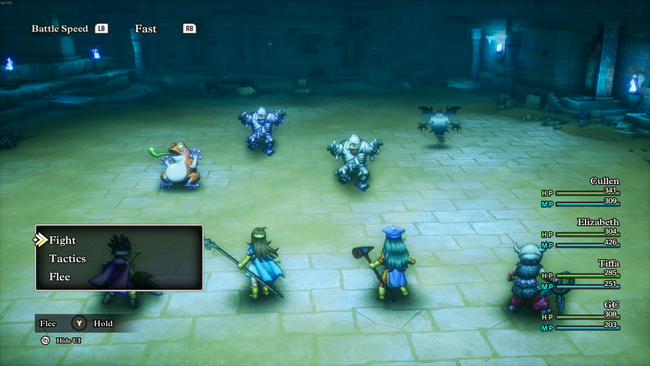
All of this is to say that the battle system is simple, but with plenty of hidden depth to chip away at during your 40-hour playthrough. To me at least though, that’s not the real pull for a game like Dragon Quest III. The appeal to me is roaming a world based on our own, and being able to make a legacy for yourself. I’m here primarily to explore a beautiful and massive world. I want to loot tombs, get strong, and help people in need. Few experiences match the joy of seeing the sun rise and set as my character roamed the world, taking mental notes about my surroundings and where I should go next. The design of how your adventure plays out is surprisingly intricate for an NES game. Whenever I replay Dragon Quest III that’s always at the forefront of my mind, and I’m always impressed.
Throughout your journey are a handful of hidden added scenes to flesh out Ortega’s story. There’s a particularly touching moment where you bring back his helmet to your mother back home, and she starts to tell you the story behind it. Honestly, every new bit of dialogue with your Mom is some of the best stuff in the game. Dragon Quest III’s story was always great in capturing the small human moments, often shown in resolutions to its myriad of little episodic stories spread throughout the world. Looking for a pair of star-crossed lovers, reuniting two lost souls, or uncovering the deception around a small town. Under every story arc is something down to earth to motivate you, even if small. These new scenes feel like natural extensions to what makes the story of the original game work, and I appreciate that they often felt like rewards for going off the beaten path. I only wish there was more voice acting, which feels lacking in quantity compared to previous HD-2D efforts.
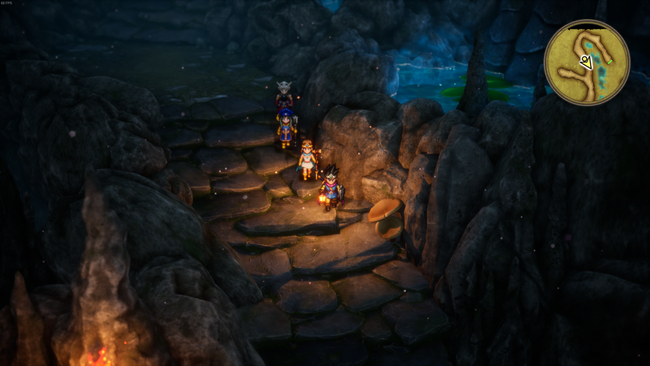
Saying a remake is “faithful” can sometimes be quite a loaded statement. A certain flavor of franchise fan may get very passionate about the specifics of an original work when it comes time for their favorite game to get remade, as any small adjustment or addition is met with heavy scrutiny. When remaking a game, it is impossible to create the exact experience as the original provided. I personally don’t care if a remake decides to do its own thing, as I’ve never seen it as a replacement for the original work. Having said this, I was quite surprised to see how much of the original experience felt intact in this HD-2D remake. There have been attempts to streamline progression by pointing players in the right direction during some of the more open-ended exploration segments, but the most that tells you is the general idea of what you should be doing.
As the Dragon Quest series transitioned into 3D, there was a shift towards making every area feel real. Buildings started to feel lived in, dungeons got more intricate, and the world felt tangible. There’s been an effort here to apply the strengths of the modern game’s map design back into Dragon Quest III, to stunning effect. This remake is without a doubt the best-looking game in the HD-2D lineage, and every place feels reasonably lived in now. Alternatively, dungeons feel even more dangerous and desolate than ever, adding to the tension of late-game dungeon crawls. The overworld map itself strikes a strong balance between the era in which Dragon Quest III was originally made and the one it finds itself in now. The now large world was brought to life beautifully, but with enough abstraction kept in place to maintain the identity of the classic RPG.
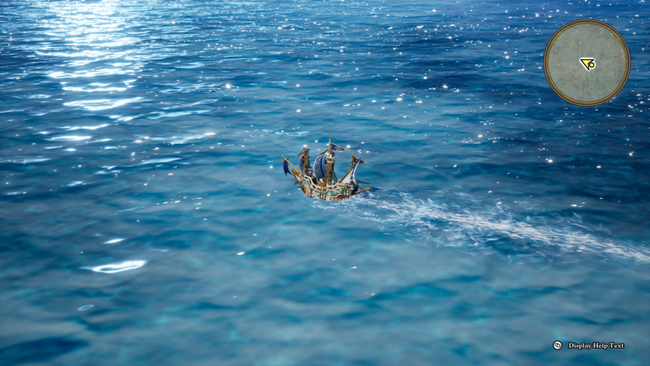
I played the Steam version of the game, jumping between my Steam Deck and PC regularly. The port itself is pretty simplistic with limited graphical options, but looks and runs great. I’m very pleased to say there are absolutely no issues running the game on Steam Deck, and that’s where I spent most of my time playing it. Setting the game to 720p at max settings allowed me to hit a locked 60 FPS, and playing it docked on my TV allowed me to reach similar results running at 1080p. I’m sad to say that higher frame rates aren’t available for the PC version, but to be fair you could hand me this game on Switch at 30 FPS and I’d probably be happy.
Almost everything you do in this remake lines up with the Super Famicom version, with the exclusion of the Pachisi minigame. You visit the same dungeons, see the same story beats, fight the same monsters - although there are some new bosses sprinkled throughout. It’s the scale of the world that feels meaningfully different. The world map feels massive, dungeons feel daunting, but the game never felt bloated to me. The design philosophy from the designers seemed to be to expound on what the original did, but never take it too far. If anything the additions only enhance the experience in my eyes, like adding a handful of new bosses sprinkled throughout mandatory story dungeons that lacked them.
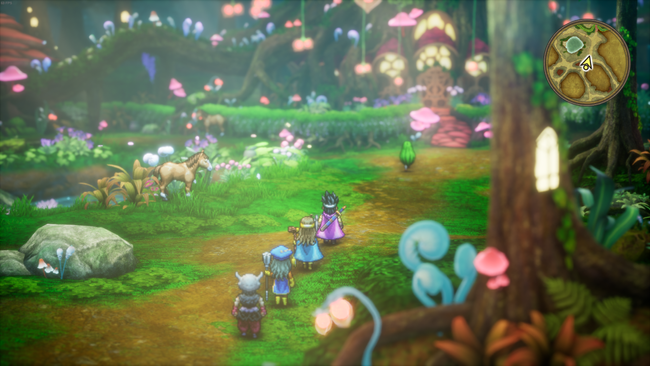
There are just enough tweaks here to add a level of polish to make the classic game design shine, and just enough added to the writing to have newcomers not feel too alienated from the simple storytelling. The game feels more focused than before, with a strong understanding of what makes Dragon Quest III so great. The inclusion of new Secret Spots on the map where you can find more loot or recruitable monsters pushes you to explore, which is a great way to adapt the sense of adventure to a world no longer restrained by a top-down camera and simplistic tilesets.
Something I respect immensely is how the developers give the players the freedom to choose how much of the original experience they want. The appeal of early Dragon Quest games, in my opinion, is how they evoke wanderlust. You feel as if you’re traveling across a sprawling and unknown world, with every landmark or town being a chance for new adventures. This can lead to them being obtuse to many, and an attempt was made to make it a bit more newcomer-friendly. In the menu is an option to turn on or off objective markers, previously seen in the HD-2D remake of Live A Live. I played the entire game with objective markers off and my objective list hidden. This offered me an experience that still felt plenty open, while sanding off the frustrating edges of the obtuse design. All that’s left are the charming parts, and I couldn’t get enough of it.
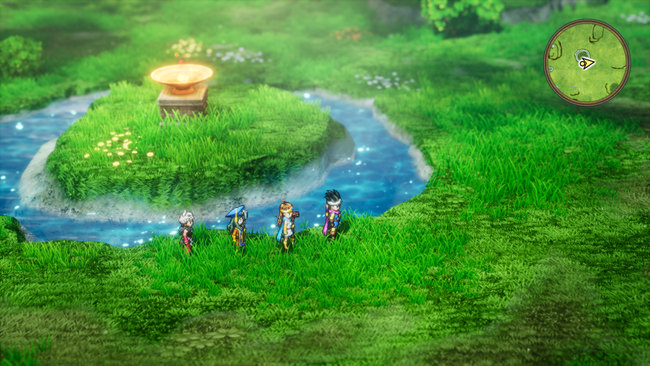
I’m surprised to say that my biggest takeaway from this remake is that I’m excited beyond belief to see this team’s take on Dragon Quest II. I’ve always been really fond of that game in particular out of the original trilogy, with it feeling like a prototype for III that just couldn’t entirely get off the ground in the same way. The best parts of III in any version are when you’re boating around the world with only some small leads on how to accomplish your goals, and that’s basically what II is in a nutshell. Expanding that game’s scope out, fleshing out the story, and making it just a little bit easier to find out where you’re going could make that an all-timer Dragon Quest game. Maybe that’s wishful thinking, but this remake has me plenty optimistic about next year’s remake of I and II.
My second takeaway was a newfound appreciation for this classic game. Dragon Quest III is one of the most important games of all time. Anyone savvy with Google could tell you this. RPGs have come a really long way, but DQIII has always felt a bit ahead of its time. Artdink has done a truly impressive job trying to preserve it as it was, and this HD-2D remake is a fascinating time capsule of one of the RPG genre’s first breakout successes. So much of the spirit is intact in all its retro glory, but the increase in scale and presentation makes it stand out amongst modern contemporaries. After a while, I stopped trying to look out for various changes, and just started enjoying replaying Dragon Quest III. All of the adventure, the exciting battles, and nostalgia are here. The moments of frustration and triumph I yearn for every time I come back to this game are preserved. This is Dragon Quest III, plain and simple. It felt like coming home.